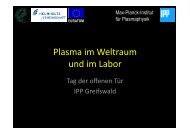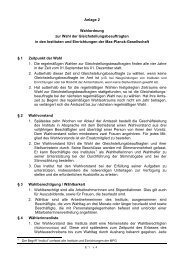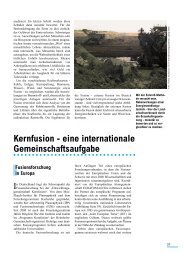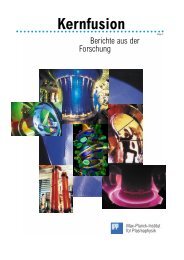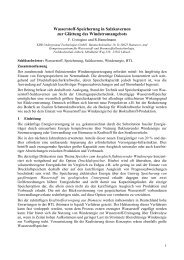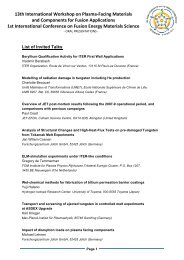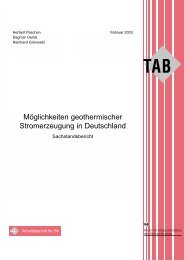IPP Annual Report 2007 - Max-Planck-Institut für Plasmaphysik ...
IPP Annual Report 2007 - Max-Planck-Institut für Plasmaphysik ...
IPP Annual Report 2007 - Max-Planck-Institut für Plasmaphysik ...
You also want an ePaper? Increase the reach of your titles
YUMPU automatically turns print PDFs into web optimized ePapers that Google loves.
oscillations) keeps the profiles in a stable regime. Pellet<br />
injection into ohmic plasmas showed a directly pellet driven<br />
MHD perturbation exceeding by far that one present at the<br />
visible ELM onset thought to be in the order required for<br />
ELM triggering. No correlation was found between the<br />
MHD perturbations with pellet particle ablation or deposition<br />
rate, indicating an already saturated driving mechanism.<br />
Lower local plasma energies result however in a reduction<br />
of the MHD excitation attainable by the pellet perturbation.<br />
The correlation between pellet MHD drive and plasma<br />
parameters are now under investigation.<br />
7.4 Parallel plasma flow and radial E-field in the SOL<br />
The fast reciprocating probe located 30 cm above the torus<br />
midplane was used to investigate the SOL from the limiters<br />
up to the separatrix. It was equipped with swept Langmuir<br />
probes facing in co- and counter-current direction. This<br />
allowed the floating potential (V fl ), the electron density (n e )<br />
and temperature (T e ) and the Mach number (M) of the parallel<br />
plasma flow to be measured all at once. Also the plasma<br />
potential V pl =V fl +3.1T e and the radial electric field E r =-∇ r V pl<br />
could be deduced. In a series of ohmic discharges the density<br />
was varied covering a Greenwald density fraction of<br />
f GW =0.21-0.49 with I p =1 MA and B t =-2 T. The outer divertor<br />
was fully attached at f GW =0.21 and fully detached at<br />
f GW =0.49. On both sides of the probe head the same T e was<br />
found, but compared to values from Thomson scattering<br />
(TS) T e was considerably lower for ΔR=R-R sep 1 cm). When the outer<br />
divertor was (partially) detached M≤0.6 was found at the<br />
separatrix decreasing to M≈0.2 at ΔR≈0.5 cm and rising<br />
again further outward (M≤0.4). Close to the separatrix the<br />
Pfirsch-Schüter and “return flow” can cause the observed<br />
flows but for ΔR>0.5 cm there has to be another contribution<br />
like e.g. a transport related flow. Flow and divertor<br />
detachment are possibly related.<br />
7.5 Impurity flux in SOL<br />
Ion fluxes in the SOL were measured by exposure of collector<br />
probes with the midplane manipulator system and subsequent<br />
quantification of deposited deuterium and impurity<br />
elements by ex-situ ion beam analysis. Discharge-resolved<br />
and even time-resolved measurements within one discharge<br />
can be carried out employing rotating cylindrical samples<br />
inside a shield with a 6 mm wide slit aperture extending<br />
88 mm in a radial direction. Increased impurity fluxes are<br />
observed during the low density current ramp-up phase as well<br />
as in plasma configurations with a small separatrix-sample<br />
distance and increased ion cyclotron resonance heating<br />
ASDEX Upgrade<br />
18<br />
(ICRH) power. The increase of the impurity flux in the first<br />
two cases is attributed to an increased wall flux and correspondingly<br />
higher sputtering flux. In the latter case the interaction<br />
of the ICRH antenna with the plasma is expected to<br />
create a local impurity source increasing with heating power.<br />
In recent experimental campaigns, apart from the dominant<br />
first wall element tungsten, the main impurities were calcium<br />
(from ceramic isolation) and steel constituents (Fe, Ni) from<br />
the vacuum vessel. The derived concentrations of c Fe ≈10 -3<br />
and c W ≈10 -5 at the plasma edge are in good agreement with<br />
spectroscopic measurements. In order to quantify the edge<br />
carbon flux with a full tungsten wall configuration a full<br />
metallic probe head (TZM shield, Al cylinder) has been constructed.<br />
A typical residual carbon deposition rate of a few<br />
10 21 m -2 / discharge was detected and no significant temporal<br />
evolution of the carbon flux throughout the <strong>2007</strong> campaign<br />
could be observed similar to spectroscopic investigations<br />
(see Chapter 2).<br />
7.6 Analysis of divertor profiles<br />
Dedicated discharges with strike point sweeps allowed power<br />
load profiles derived from Langmuir probes to be compared,<br />
assuming P LP =(7 k B T e +E rec )Γ i, and IR thermography.<br />
Figure 20 shows profiles of electron temperature, density<br />
and power fluxes along the outer target for the inter-ELM<br />
phase of a medium and a high density H-mode discharge.<br />
Coherent averaging over about 100 ELM cylces was used to<br />
reduce the statistical uncertainties. While the T e profiles<br />
along the target are flat, the density profiles are peaked close<br />
to the separatrix. For the high density H-mode the profiles<br />
indicate partial detachment around the strike point. The target<br />
profiles (T e , n e , j sat , P IR ) are very similar comparing discharges<br />
with carbon (divertor IIb) and tungsten (divertor<br />
IIc) target plates. The electron power width obtained from<br />
the Langmuir probes using a sheath transmission factor of 8 is<br />
a factor 2 shorter than the one obtained from thermography.<br />
Both widths increase with density, compatible to the trend<br />
seen for the electron temperature decay length as obtained<br />
from Thomson scattering measurements. One exponential<br />
decay length is sufficient to fit the power decay for these<br />
medium/high density conditions. While the power widths<br />
obtained from the probes are a factor 2-3 larger than the<br />
expectation 2/7·λ Te midplane , the thermographic widths are<br />
clearly out of range, suggesting dominant effects of fast ion<br />
impact and/or radiation.<br />
During ELMs, similar power loads are observed at the outer<br />
target from Langmuir probe and thermography analysis for<br />
both divertors IIb and IIc. The large deposited ELM energies<br />
observed with thermography at the inner target have<br />
shifted upward, away from the strike zone from divertor<br />
IIb to IIc. A corresponding redistribution of the target currents<br />
indicates that in fact the impact region of fast ions<br />
has shifted upward.




